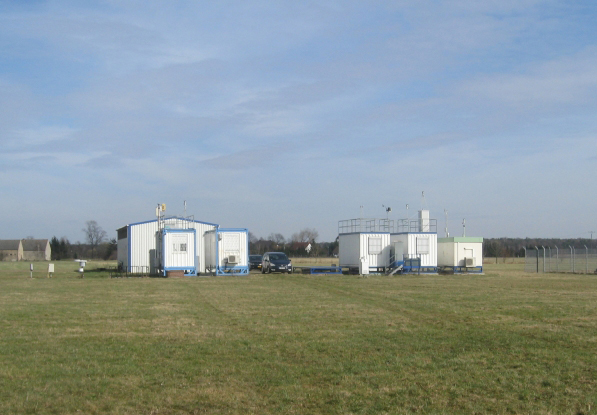
Melpitz site, view to East
(Foto: Gerald Spindler / TROPOS)

The Melpitz site is a rural background site located in Germany near the city of Torgau in the glacial valley of the river Elbe (12°56’E, 51°32’N, 86 m a.s.l.). The research station Melpitz was operated by the Leibniz-Institute of Tropospheric Research (TROPOS), Leipzig. The site is integrated in EMEP (level 3, code DE44) in collaboration with the German Federal Environment Agency and a GAW regional station.
The measuring field is situated on a flat meadow surrounded by agricultural land (Spindler et al. 2001; 2010). Results of aerosol characterization from this station were compared with results from other stations in Europe (EMEP 2010, 2016; Hamed et al. 2010; Aas et al. 2012; Alastuey et al. 2016) and used for estimating different sources and rural background concentrations in comparison to cities in the surroundings (e.g. Herrmann et al. 2006; Gnauk et al. 2011). The dominating wind-direction sector for Melpitz is South-West and maritime air reach the field after crossing a large area of the western part of middle Europe. The second main wind direction sector is East with mostly dry continental air masses influenced by long range transport from anthropogenic emissions in Poland, Belarus, Ukraine, Slovakia, and the Czech Republic arrive Melpitz. There are only very few local sources for anthropogenic emissions in direction East in Germany in close distance to the Polish border which is only about 130 km east of Melpitz. The Melpitz site is representative for a large rural area in Saxony (East and North-East German lowlands). The mean yearly mass concentration in 2011 for particles PM10 and PM2.5 were found to be 24.1 µgm-³ and 20.1 µgm-³, respectively. The mean PM2.5/PM10 ratio was 0.83. Such quite high PM2.5/PM10 ratios are typical for rural lowland sites in central Europe.

Melpitz site, view to East
(Foto: Gerald Spindler / TROPOS)
Aas, W., Tsyro, S., Bieber, E., Bergström, R., Ceburnis, D., Ellermann, T., Fagerli, H., Fröhlich, M., Gehrig, R., Makkonen, U., Nemitz, E., Otjes, R., Perez, N., Perrino, C., Prévôt, A.S.M., Putaud, J.-P., Simpson, D., Spindler, G., Vana, M., Yttri, K.E.: Lessons learnt from the first EMEP intensive measurement periods. Atmos. Chem. Phys. 12, 8073-8094 (2012)
Alastuey, A., Querol, X., Aas W., Lucarelli, F., Pérez, N., Moreno, T., Cavalli, F., Areskoug, H., Balan, V., Catrambone, M. , Ceburnis, D., Cerro, J.C., Conil, S., Gevorgyan, L., Hueglin, Ch., Imre, K.,Jaffrezo, J.-L., Leeson, S.R., Mihalopoulos, N.,Mitosinkova, M., O’Dowd, C.D., Pey, J., Putaud, J.-P., Riffault, V., Ripoll, A., Sciare, J., Sellegri, K., Spindler, G., Yttri, K.E.: Geochemistry of PM10 over Europe during the EMEP intensive measurement periods in summer 2012 and winter 2013. Atmos.Chem.Phys 16, 6107-6129 (2016)
EMEP: Joint Report of the Task Force on Measurements and Modelling (TFMM), Air pollution trends in the EMEP region between 1990 and 2012. Chemical Co-ordinating Centre (CCC), Meteorological Synthesizing Centre-East (MSC-E), Meteorological Synthesizing Centre-West (MSC-W) (2016) http://www.unece.org/fileadmin/DAM/env/documents/2016/AIR/Publications/Air_pollution_trends_in_the_EMEP_region.pdf
EMEP Transboundary particulate matter in Europe Status report 2010 NILU Reference: O-98134. ISSN 1504-6192 Contributors: Yttri, K.-E., Aas, W., Tørseth, K., Stebel, K., Fahre Vik, A., Fjæraa, A.M., Hirdman, D., Tsyro, S., Simpson, D., Marečková, K., Wankmüller, R., Klimont, Z., Kupiainen, K., Amann, M., Bergström, R., Nemitz, E., Querol, X, Alastuey, A., Pey, J., Gehrig, R. www.nilu.no/projects/ccc/reports/emep4-2010.pdf
Gnauk, T, Müller, K, Brüggemann, E., Birmili, W., Weinhold, K, van Pinxteren, D., Löschau, G., Spindler, G., Herrmann, H.: A study to discriminate local, urban and regional source contributions to the particulate matter concentrations in the city of Dresden, Germany. J. Atmos.Chem. 68, 199-231 (2011)
Hamed, A., Birmili, W., Joutsensaari, J., Mikkonen, S., Asmi, A., Wehner, B., Spindler, G., Jaatinen, A., Wiedensohler, A., Korhonen, H., Lehtinen, K. E. J., Laaksonen, A.: Changes in the production rate of secondary aerosol particles in Central Europe in view of decreasing SO2 emissions between 1996 and 2006. Atmos. Chem. Phys. 10, 1071-1091 (2010)
Herrmann, H., Brüggemann, E., Franck, U., Gnauk, T, Löschau, G., Müller, K., Plewka, A., Spindler, G.: A source study of PM in Saxony by size-segregated characterisation. J. Atmos. Chem. 55, 103-130 (2006)
Klejnowski, K., Kozielska, B., Krasa, A., Rogula-Kozłowska, W.: Polycyclic aromatic hydrocarbons in PM1, PM2.5, PM10 and TSP in the upper Silesian agglomeration, Poland. Archives of Environnmental Protection 36, 65-72 (2010)
Spindler, G., Teichmann, U., Sutton, M.A.: Ammonia dry deposition over grassland – Micrometeorological flux-gradient measurements and bi-directional flux calculations using an Inferential Modell. Q.J.R.Meteorol.Soc. 127, 795-814 (2001)
Spindler, G., Brüggemann, E., Gnauk, T., Grüner, A., Müller, K., Herrmann, H.: A four-year size-segregated characterization study of particles PM10, PM2.5 and PM1 depending on air mass origin at Melpitz. Atmos. Environ. 44, 164-173 (2010)
Spindler, G., Gnauk, T., Grüner, A., Iinuma, Y., Müller, K., Scheinhardt, S., Herrmann, H.: Size-segregated characterization of PM10 at the EMEP site Melpitz (Germany) using a five-stage impactor: a six year study. J. Atmos. Chem. 69, 127-157 (2012)